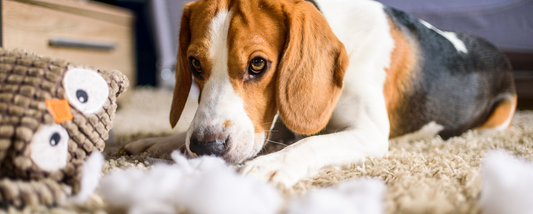Eat, play, sleep!
Have you ever caught yourself thinking, “My dog has the best life! Eat, play, then sleep for hours on end.” Well, according to the American Kennel Club, dogs spend 50% of their day sleeping, 30% awake but lounging, and 20% being active. Puppies and older dogs require even more sleep and can sleep up to 20 hours during the day. What a life!
Age, size and breed type also are factors for how much sleep a dog requires. For example, larger dogs tend to sleep more than smaller dogs. The pattern of a dog’s sleep cycle follows very closely to that of humans.
The difference is that humans spend about 25% of their sleep time in REM sleep, and dogs only spend about 10% in this sleep state. REM is characterized by distinctive eye movements and is the stage where dreams happen. REM sleep is the last stage in the sleep cycle to occur before the sleep cycle repeats itself. Those who wake up right after a REM cycle feel more refreshed and well rested.
What happens when a dog falls asleep?
Like humans, there are stages that a dog transitions through after curling up into their favorite sleep position.
- Their breathing slows down and they begin to drift into a light sleep. Their heart rate will close down and their blood pressure will drop.
- Within 10 minutes, they enter into REM stage of sleep. Cue the twitching! Many times this is when you will see your dog run in their sleep. In addition, some dogs bark in their sleep. This does not necessarily mean they are having a bad dream.
- This is followed by a period of light and deep sleep.
According to Dr. Stanley Coran, a former psychology professor at the University of British Columbia and neuropsychological researcher, dogs dream during REM sleep just like humans do. He states that an average-sized dog will dream every 20 minutes and the typical dream lasts one minute. Larger dogs, however, have fewer dreams but each one lasts longer.
When are twitches abnormal?
Some dogs may, in fact, experience medical issues including seizures during sleep. These have a different pattern than normal sleep twitching. If your dog has trouble waking up after a period of twitching or has full body shakes along with foam, or vomit from the mouth, or in some cases a loss of urine or bowel movements, your dog may be having a seizure.
It is important to notify your vet if you see any of these symptoms occur. Your vet will be able to run blood work as well as perform a physical and neurological exam to help determine what the cause might be.
Dream on!
While seeing and hearing your dog while they are in the midst of a dream can sometimes be alarming, allow them to finish out their dream. If you feel the need to wake them up, gently call their name. Do not shake them as some dogs can have a heightened reaction when being woken up. It’s best to go with the phrase “let a sleeping dog lie” and allow them to enjoy their restful sleep!
Have you snapped a video of your pup while they are dreaming? Tag us on Instagram for a chance to be featured!





